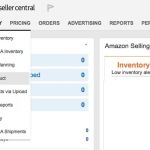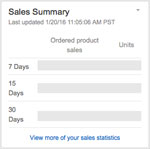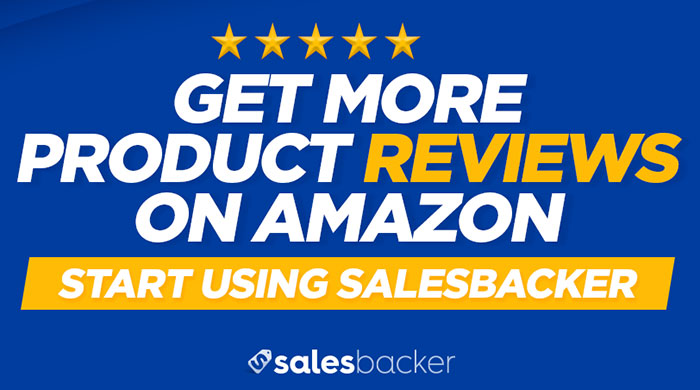PPC advertsing can be incredibly effective at helping you get more sales, but it's very important to follow up a PPC strategy with a way to convert your buyers into reviewers and that's where Salesbacker can help. Salesbacker takes just minutes to implement one time and then you can capitalize on all of your PPC sales and have a chance at converting those buyers into reviewers. Try Salesbacker here.
Ask any successful and seasoned Amazon seller what their top three tools to success are, and I guarantee you that PPC will rank in the top three for nearly every one of them.
Amazon’s pay-per-click (PPC) Advertising enables you to advertise to a huge number of people who are not just browsing online but are browsing online to buy something! AND they’re not just buying anything; Amazon let’s you target customers who are wanting to buy a product like yours! How could you ask for a better place to put your advertising dollars? And that is why successful Amazon sellers rely on it so heavily.
If you’re just getting started on Amazon, PPC is even more important. Organic traffic is always best, but it often takes a long time to gain traction. So in order to start ranking your product and getting in front of potential customers, you’ll need to invest in PPC at first. As you gain more and more sales, reviews, and climb the listings, you’ll be able to scale back your dollars and ride the wave of organic traffic.
Thankfully, setting up an Amazon PPC campaign isn’t difficult to do if you follow these simple instructions. Once you’ve gotten your first campaign set up, you’ll want to gain as much insight from your campaign as possible in order to make your PPC dollars an effective investment.
For now, let’s get your first PPC campaign up and running.
HOW TO SET UP AN AMAZON PPC CAMPAIGN
1. Sign in to your Seller Central account, then on your homepage, hover over Advertising. From the Advertising menu, choose Campaign Manager:

2. On the Campaign Manager page, you’ll be asked to “Set up your campaign budget and duration”. Most of this is fairly basic, but let me make a few points relating to this section:
- When you name your campaign, keep in mind that you can create multiple ad groups within a campaign, so choose a broad campaign name. For example, if you are running ads during the winter months of January and February, you could name it “Winter 2016”. But within that campaign, you can create multiple ad groups with differing keywords. You’ll be asked to name the ad group on the next page. You might name ad groups “Winter 2016 A” and “Winter 2016 B”. These names are for your reference only.
- When setting your daily budget, remember that your daily budget adds up fast. So a $25 daily budget will cost you $350 in two weeks. In other words, decide what your monthly budget should be first, then determine the daily budget.
- When choosing the beginning and end dates of your campaign, I always recommend choosing an end date as opposed to leaving it open. If you get really busy with another project, you don’t want to be burning through advertising dollars without realizing it. You may want to simply choose a length of one month in order to get sufficient data from your report.
- If you choose “Automatic targeting”, Amazon will auto-generate a campaign of keywords based upon the product you’re advertising. This can be beneficial if you’re simply looking for data from customer searches. However, “Manual Targeting” will allow you to determine which keywords will be used for your campaign. For our example, we’ll choose “Manual Targeting”.
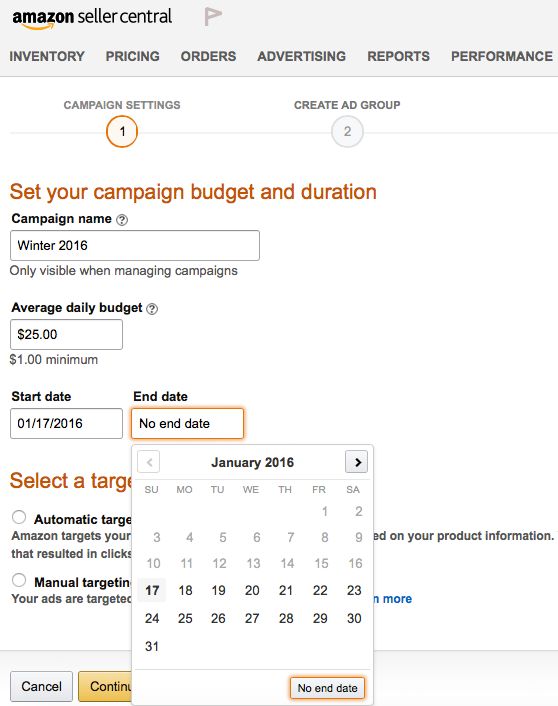
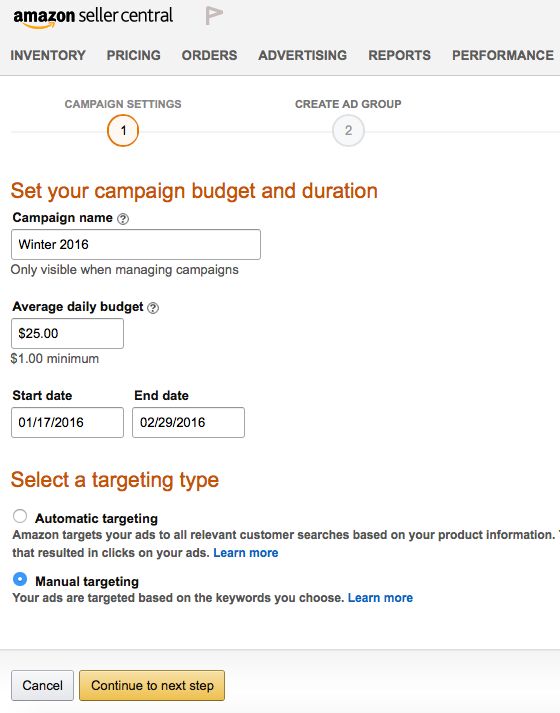
Once you’ve entered your information and made the appropriate selection, click on “Continue to next step”.
3. On the next page, you’ll be asked to “Name this group of ads”. Keep in mind that you can add multiple ad groups to the same campaign, so choose an appropriate name that will distinguish it from other ad groups.
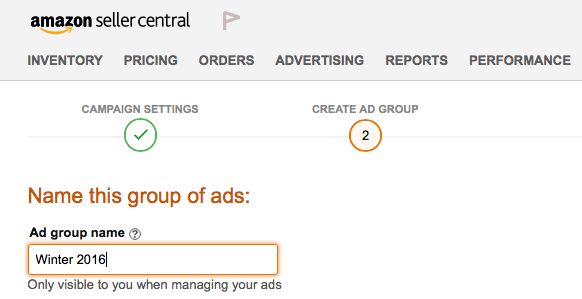
4. Next, you’ll choose which product you’d like to advertise. You can only choose one product for each campaign.
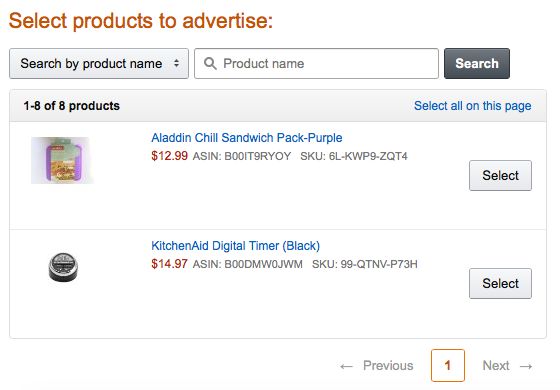
5. Now you’ll need to choose how much you’re willing to spend for each keyword. Keep in mind that by setting your daily budget and keyword bid, you’re determining how many clicks per day you can get. For example, if you set your daily budget at $10 and your keyword bid at $1, you will only receive 10 clicks per day on your ad (if you’re bids actually cost $1). So be sure to set these amounts for maximum effectiveness.

6. Next, you’ll need to choose your keywords. This is by far the trickiest and perhaps most important part of your campaign. For now, don’t worry about being an expert on keywords. At first, you’ll mostly be learning from experimentation.
You’ll notice that Amazon offers some suggested keywords. If you don’t have a list already created, you may simply choose one or more of Amazon’s suggestions. As you choose their suggestions, the keywords will appear in the box below.
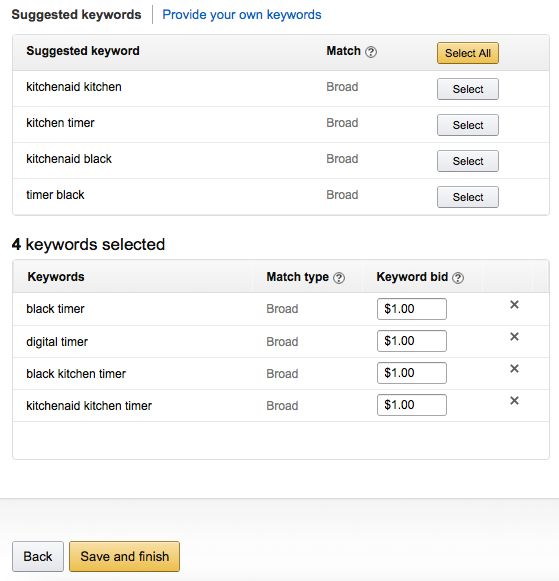
If you do have specific keywords you wish to run, click on “Provide your own keywords”, then enter one keyword per line. You may also choose whether you want to match the word on a “Broad” basis, a “Phrase” match, or an “Exact Match”. If you’d like to learn more about how each of these search types function, see our article “Broad, Phrase, or Exact Match: Which Search Type Should I Use?”.
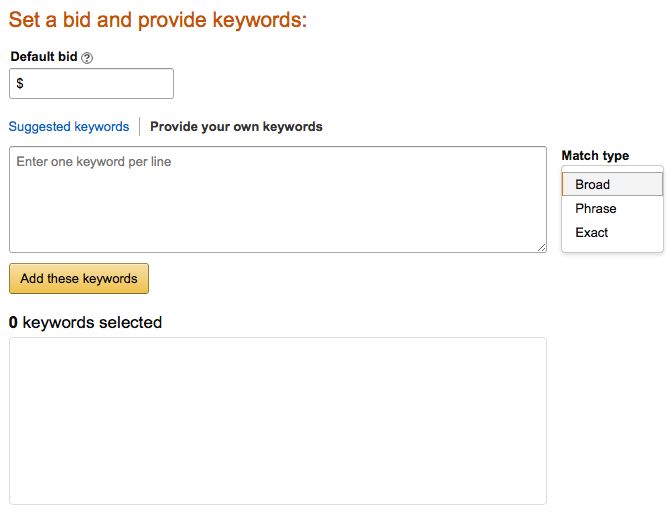
7. Once you’ve finished entering your keywords, click on “Save and Finish” at the bottom of the screen.
8. After you’ve completed your campaign information, you’ll be taken back to your Campaign Manager page where you should receive a “Success!” message. Notice that new campaigns typically take approximately one hour before the ads begin appearing in searches.
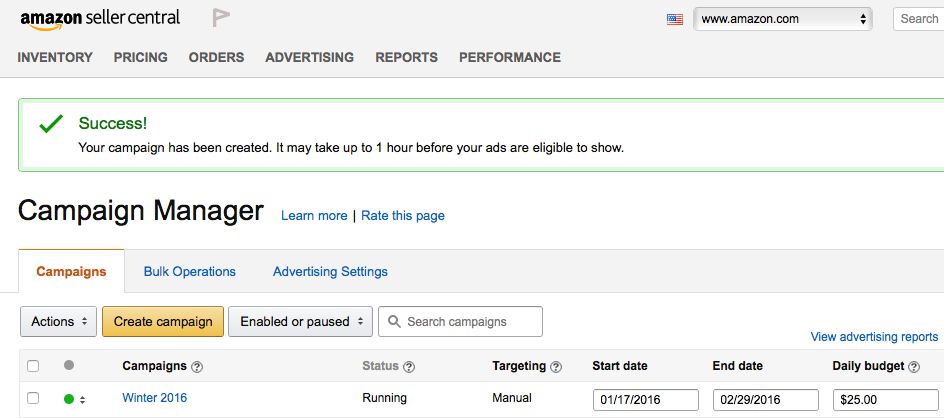
Conclusion
Congratulations! You’ve successfully created an Amazon advertising campaign that could begin giving your product the kind of exposure it needs.
What’s next? Patience. You’ll certainly want to monitor the success of the keywords you chose, however, it takes time to collect data that will inform which keywords to trash and which to keep.
Setting up a PPC campaign is only the beginning of your journey to successful Amazon marketing. Don’t be discouraged if your initial campaign doesn’t go as well as you expected. The better you get at setting your advertising budget and choosing successful keywords, the more efficient your campaigns will become in getting your advertising spending down and your sales up.
Successful PPC Ad Campaigns follow the formula for success - Create. Analyze. Revise. Repeat. You can do the same!
Great! Your PPC campaigns are set up. Now start using Salesbacker to capitalize on your increased sales so that you can help convert your buyers into more product reviews. The more product reviews you get, the better conversion rate you'll see and the more sales you can get. It's an awesome cycle. Start your Salesbacker free trial here.

